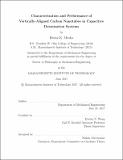| dc.description.abstract | Less than 1% of the world's 1.4 billion km³ of water is available freshwater. In contrast, 98% of the world's water is in the form of brackish and seawater (1000-35,000 ppm or 10-600 mM NaCl concentration). Desalination can increase our water supplies, generating sufficient water for household, industrial, and agricultural uses and mitigating the escalating water crisis. As one strategy for water desalination, capacitive deionization (CDI) could prove optimal for brackish water treatment, due to its higher energy efficiencies compared to reverse osmosis and its more inherent resistance to fouling. CDI is a developing technology where adsorption capacity and salt removal rates into porous, tortuous carbon electrodes is still low. Previously, a breadth of carbon material electrodes have been investigated for CDI, due to their high surface area to volume ratio, high conductivity and non-corrosive property in salt water. However, many carbon materials have tortuous pores making it challenging to decouple the role of pore diameter on salt adsorption rate. To simplify the characterization of the electrode, we took advantage of vertically-aligned carbon nanotubes (VA-CNTs). VA-CNTs are an exciting material for investigating the coupling of the electrode and ion transport in a flow-cell due to the ability to manipulate the inter-CNT spacing, to study changes in the ion transport rate as a function of geometry, while maintaining minimal tortuosity and intrinsic capacitance. In this work, we utilized monolithic VA-CNT forests to investigate the coupling of device geometry and porous electrode design on the performance of flow-by CDI devices, specifically examining changes in salt adsorption rate, salt adsorption capacity, and salt rejection. First, we designed and characterized VA-CNT electrodes using standard three-electrode beaker experiments. These VA-CNTs were grown using a standard chemical vapor deposition of ethylene on silicon wafers with iron catalyst. In addition, we mechanically densified these forests to achieve densities greater than 25x the density of as-grown forests. We measured the capacitance and impedance spectra of VA-CNT electrodes in 1M NaCl, finding that they have a capacitance of 22-35 F/g or 7-11 [mu]F/cm². From the impedance spectra, we used a modified transmission line model to calculate the inter-CNT spacings which are up to 100 nm in sparse forests, and as low as 25 nm in our high volume fraction forests. This simple electrochemical approach can be used to characterize electrodes and predict performance in flow-by CDI devices. Second, we used a flow-by CDI experimental set up to study the role of varying voltages, electrode thicknesses, and CNT densities, on desalination performance. We found that in a 1 mM NaCl solution, CNT electrodes adsorbed from 4-8 mg salt/g carbon, at rates of 0.2-0.4 mg/g-min. Through densification or reduction in electrode thickness, we could maintain our gravimetric salt adsorption while increasing or reducing the salt adsorption rate proportionally to the diffusion time constant. This demonstrated that desalination in these cells is limited by diffusion from the flow channel into the electrode. These investigations provide a framework for studying the performance of a CDI cell for a given electrode. Finally, we combined the experimental investigations with an advection-diffusion model to inform the design of carbon electrode materials for optimal ion adsorption and throughput in a flow-by CDI device. We developed a model that is dependent on device specification parameters (system volume, flow rate, inlet and outlet water quality) and independent of electrode material, to generalize the design of a cell for any given requirement. We showed that decreasing the advection-diffusion Péclet number and increasing the aspect ratio of the electrode compared to the channel space yields the highest salt rejection. In addition, tuning the duty cycle for salt rejection instead of complete electrode charging can yield faster water production rates and optimal salt rejection. This thesis provides a framework for the selection and design of flow-by CDI devices for optimal salt rejection for given specifications. This investigation uses VA-CNTs as a proof-of-concept approach which can be extended to the multitude of porous carbon materials used in existing devices. | en_US |
